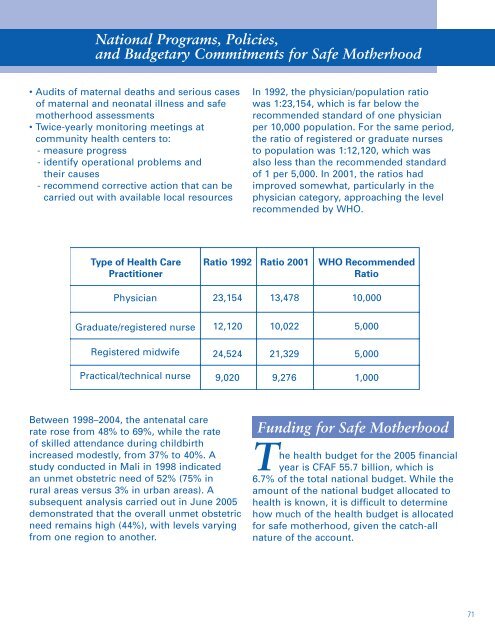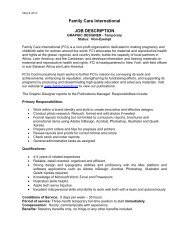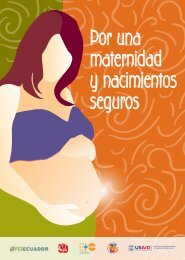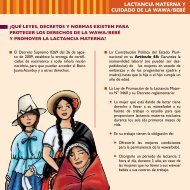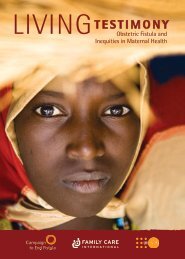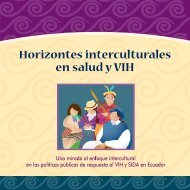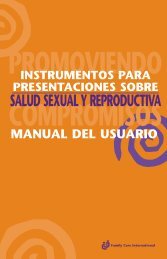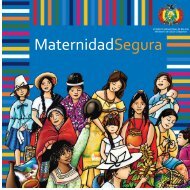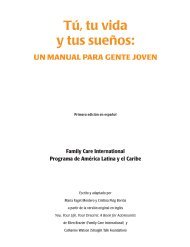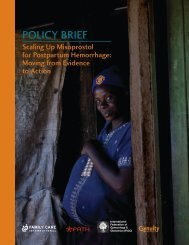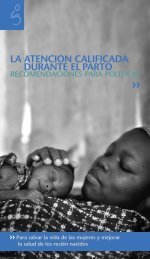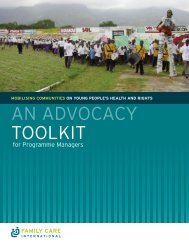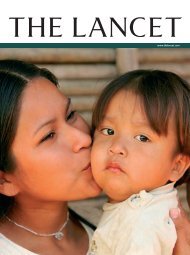Safe Motherhood: A Review - Family Care International
Safe Motherhood: A Review - Family Care International
Safe Motherhood: A Review - Family Care International
You also want an ePaper? Increase the reach of your titles
YUMPU automatically turns print PDFs into web optimized ePapers that Google loves.
National Programs, Policies,<br />
and Budgetary Commitments for <strong>Safe</strong> <strong>Motherhood</strong><br />
• Audits of maternal deaths and serious cases<br />
of maternal and neonatal illness and safe<br />
motherhood assessments<br />
• Twice-yearly monitoring meetings at<br />
community health centers to:<br />
- measure progress<br />
- identify operational problems and<br />
their causes<br />
- recommend corrective action that can be<br />
carried out with available local resources<br />
Type of Health <strong>Care</strong><br />
Practitioner<br />
Physician<br />
Graduate/registered nurse<br />
Registered midwife<br />
Between 1998–2004, the antenatal care<br />
rate rose from 48% to 69%, while the rate<br />
of skilled attendance during childbirth<br />
increased modestly, from 37% to 40%. A<br />
study conducted in Mali in 1998 indicated<br />
an unmet obstetric need of 52% (75% in<br />
rural areas versus 3% in urban areas). A<br />
subsequent analysis carried out in June 2005<br />
demonstrated that the overall unmet obstetric<br />
need remains high (44%), with levels varying<br />
from one region to another.<br />
In 1992, the physician/population ratio<br />
was 1:23,154, which is far below the<br />
recommended standard of one physician<br />
per 10,000 population. For the same period,<br />
the ratio of registered or graduate nurses<br />
to population was 1:12,120, which was<br />
also less than the recommended standard<br />
of 1 per 5,000. In 2001, the ratios had<br />
improved somewhat, particularly in the<br />
physician category, approaching the level<br />
recommended by WHO.<br />
Ratio 1992 Ratio 2001 WHO Recommended<br />
Ratio<br />
23,154<br />
12,120<br />
24,524<br />
Practical/technical nurse 9,020<br />
13,478<br />
10,022<br />
21,329<br />
9,276<br />
10,000<br />
5,000<br />
5,000<br />
1,000<br />
Funding for <strong>Safe</strong> <strong>Motherhood</strong><br />
The health budget for the 2005 financial<br />
year is CFAF 55.7 billion, which is<br />
6.7% of the total national budget. While the<br />
amount of the national budget allocated to<br />
health is known, it is difficult to determine<br />
how much of the health budget is allocated<br />
for safe motherhood, given the catch-all<br />
nature of the account.<br />
71


